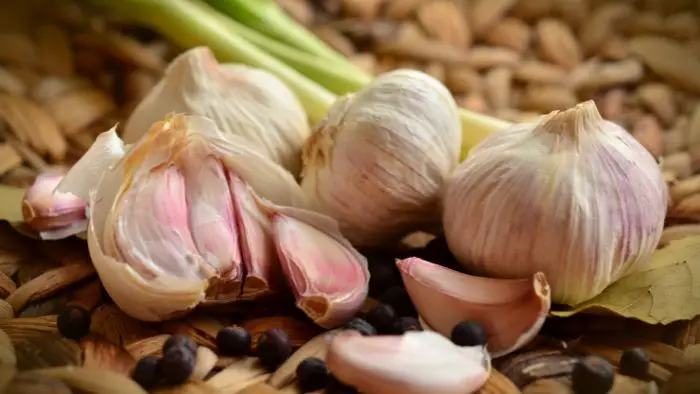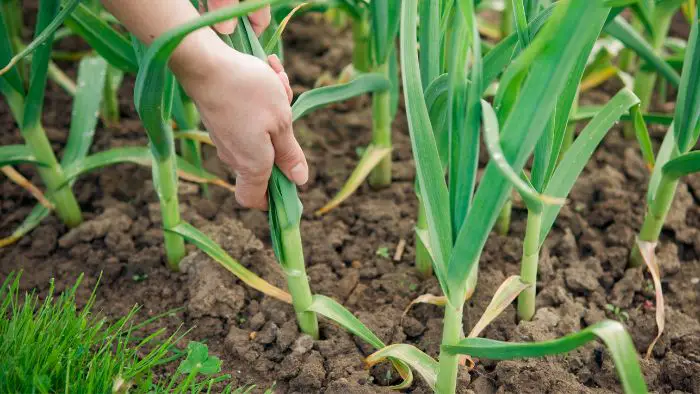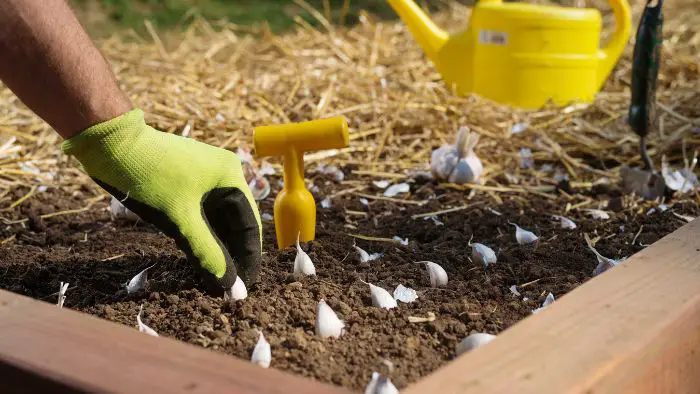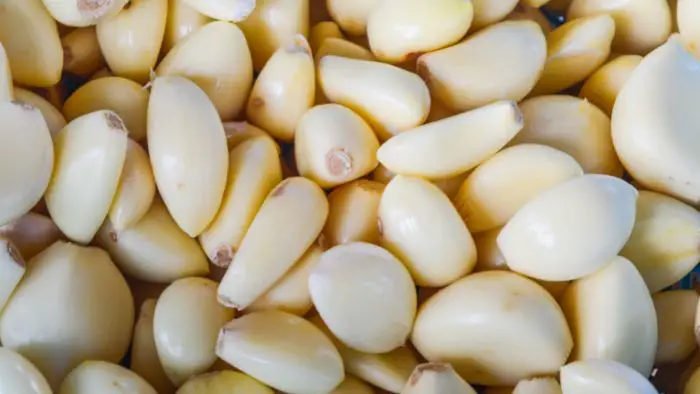Last Updated on December 12, 2022
Do you ever sit and wonder how to grow large garlic bulbs? Garlic is one of the most rewarding, and easiest vegetables to grow. But it can sometimes bring disappointment of producing very small heads. In this article, we will reveal all the secrets you didn’t know you needed on how to grow large garlic bulbs
Growing Garlic
Garlic is a popular ingredient in many savory foods that we cook at home. It has the ability to just take a dish to a whole other level. Because of this, we are motivated to grow it at home.
After growing your garlic for nearly a year, lovingly caring, diligently watering, weeding and fertilizing these plants, of course you will have to harvest large, beautiful bulbs that you will use for all of your favorite recipes.
There is no real magic involved in making this happen. It all comes down to choosing the right variety, good timing, good soil fertility and sufficient spacing between the plants when you plant them.
The Best Time To Grow Garlic
The ideal time to successfully plant garlic is in the fall season. Get the plants in the ground at least two weeks before the first frost of the season. This will give your garlic the best possible chance of surviving the harsh winter conditions by giving it abundant time to establish.
Tips On How To Grow Large Garlic Bulbs
Here are some tips on growing large garlic bulbs;
1. Select the best variety for your region
Garlic requires sufficiently cold temperatures in the winter to develop nice large heads in the spring. There are some varieties however that can tolerate warmer weather. Select a variety of seed garlic that is adapted to the area where you live. For example, do not buy seed that is great for cold areas if you live in a warm area. This will just be setting yourself up for disaster, and we do not want that.
2. Prepare the soil for planting
Garlic is tolerant of a wide range of soil types. But if you want to grow garlic with giant heads, prepare your garden soil with soil that is optimum for the plant.
Plant garlic in soil that is loose, loamy and has a high content of organic matter. This type of soil is important for good drainage in order to allow the roots to develop well.
If you would like to put fertilizer in your soil, you can do so at the time of planting, and in late spring. However, you must be careful with of over-fertilizing with nitrogen-rich fertilizers because this could lead to the plant directing its energy and nutrients towards top growth and not much energy towards growing the bulb.
3. Plant the biggest cloves
The reason for this is simple, the biggest garlic heads will produce the largest garlic cloves. Large garlic heads have enough energy stored in them that they will get your garlic off to a good growing start. They also tend to be more resistant to frost damage.
If you get your seed garlic from your own previous harvest, although the larger cloves may look more appetizing resist the urge of eating them all and save some for planting later. In the future, you will get even larger heads to grow.
4. Give them room to grow
When you plant your garlic make sure you give them enough room to grow. Planting garlic about 6 inches apart is best, and will keep them from competing for nutrients and water, resulting in larger garlic heads. This spacing is also just enough for them to provide each other with some shade which will help keep them cool.
5. Keep growing garlic cool
Keeping your garlic cool will help ensure that they grow large heads. Some of the biggest garlic is that which goes through a long, cool period of winter and early spring. This period allows it to establish its root system and prepares for head development.
Keep the soil around the garlic as cool as possible, for as long as possible to get the best chance of growing the largest heads.
Selecting a planting spot that is shaded during the hottest part of the day may also help keep the soil cool.
Mulch your soil deeply with Compost, Cocoa Mulch, or Mega Mulch, to help keep the soil cool.
6. Water deeply
Watering your garlic deeply will help it to grow a large head size. This is because the roots will be encouraged to grow deeper to find water instead of only staying in the top layer of the soil which may also be warmer.
7. Constant weeding
Constantly weed the area where your garlic is planted. This will help to ensure that the weeds do not provide unnecessary competition for nutrients and water with your garlic.
8. Remove scapes as soon as they appear
Scapes are the flower stalks that garlic produces in spring or early summer. Regularly check your garlic for these, and remove them at leaf level as soon as they appear. You can eat scapes so do not throw them out. They should just not be allowed to grow on the garlic because they take energy away which would otherwise be directed towards head growth.
9. Harvest at the right time
Make sure that you give your garlic sufficient time to grow before you harvest it.
How Long Does Giant Garlic Take To Grow?
Hardneck garlic require 12 weeks to grow too full size, if exposed to temperatures of between 40 and 50 degrees F. Other varieties such as Softneck garlic like California Early White and California Late White are a good good for warmer climates.
Should I put Miracle Grow on my garlic?
Miracle Gro is a good all purple food for plants such as garlic. It can be applied every two weeks with a garden feeder and will help your garlic heads get larger.
What Is The Best Fertilizer For Garlic?
All purpose fertilizer is good for garlic and will help it grow large and healthy. Other good options are blood meal, pelleted chicken manure or a synthetic source of nitrogen.
What Happens If You Plant Garlic Too Deep?
Planting garlic too deep can result in poor growth of the plant, and can even kill it. Garlic needs a bit of sun to establish itself, and will not be able to do so if planted too deep.
Conclusion – How To Grow Large Garlic Bulbs
Growing garlic has never been easier. Follow all the tips provided in this article and you will grow the largest garlic you ever have.
We hope this article on how to grow large garlic bulbs has provided you with all the tips you needed. Happy gardening.

An aquaculture specialist and freelance writer. Passionate about anything sustainable living, such as growing your own food, and if you can do it in conjunction with fish farming, even better! I currently work as an aquaculture researcher where I can expand and share my knowledge and skills on aquaculture, crop farming and adding value to wastewater by using it to grow food products. I enjoy reading and learning as much as possible, and writing is another avenue for me to share the knowledge I gain with others. I want my writing to inspire people to try their hand at gardening, whether indoors or outdoors. You can even start by keeping a few houseplants indoors to help you gain a bit of confidence if you need to.





